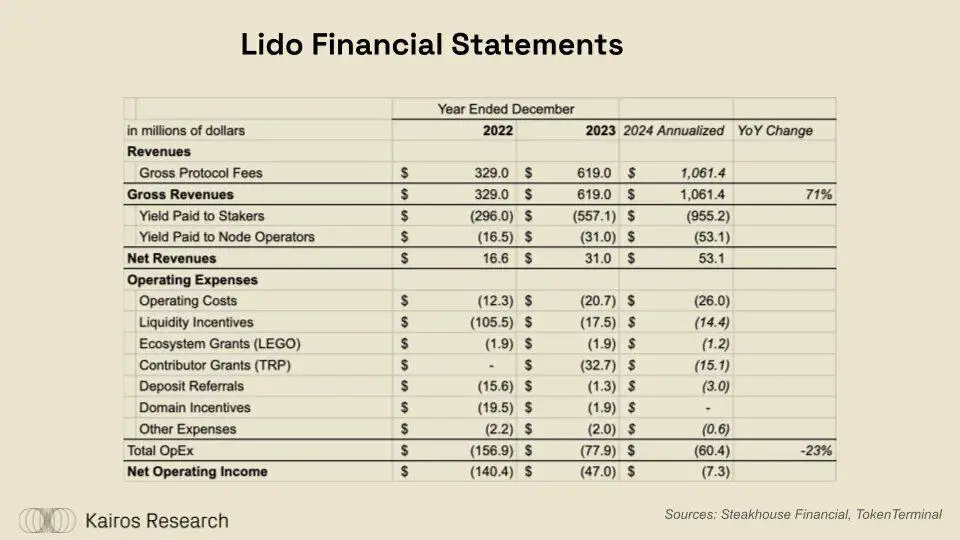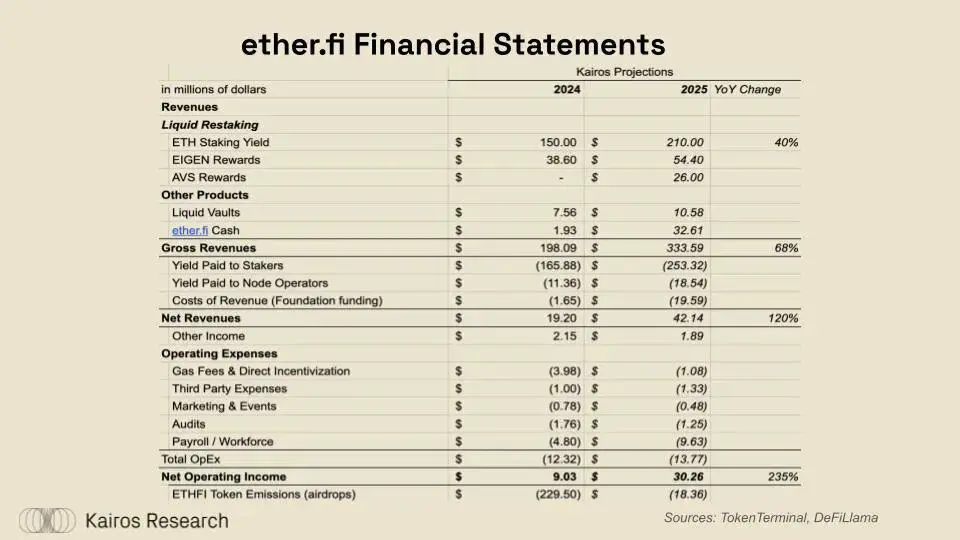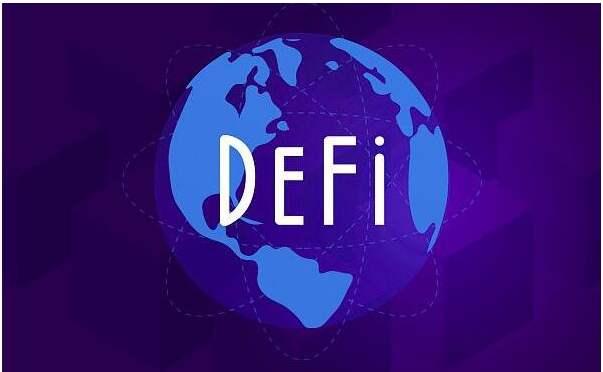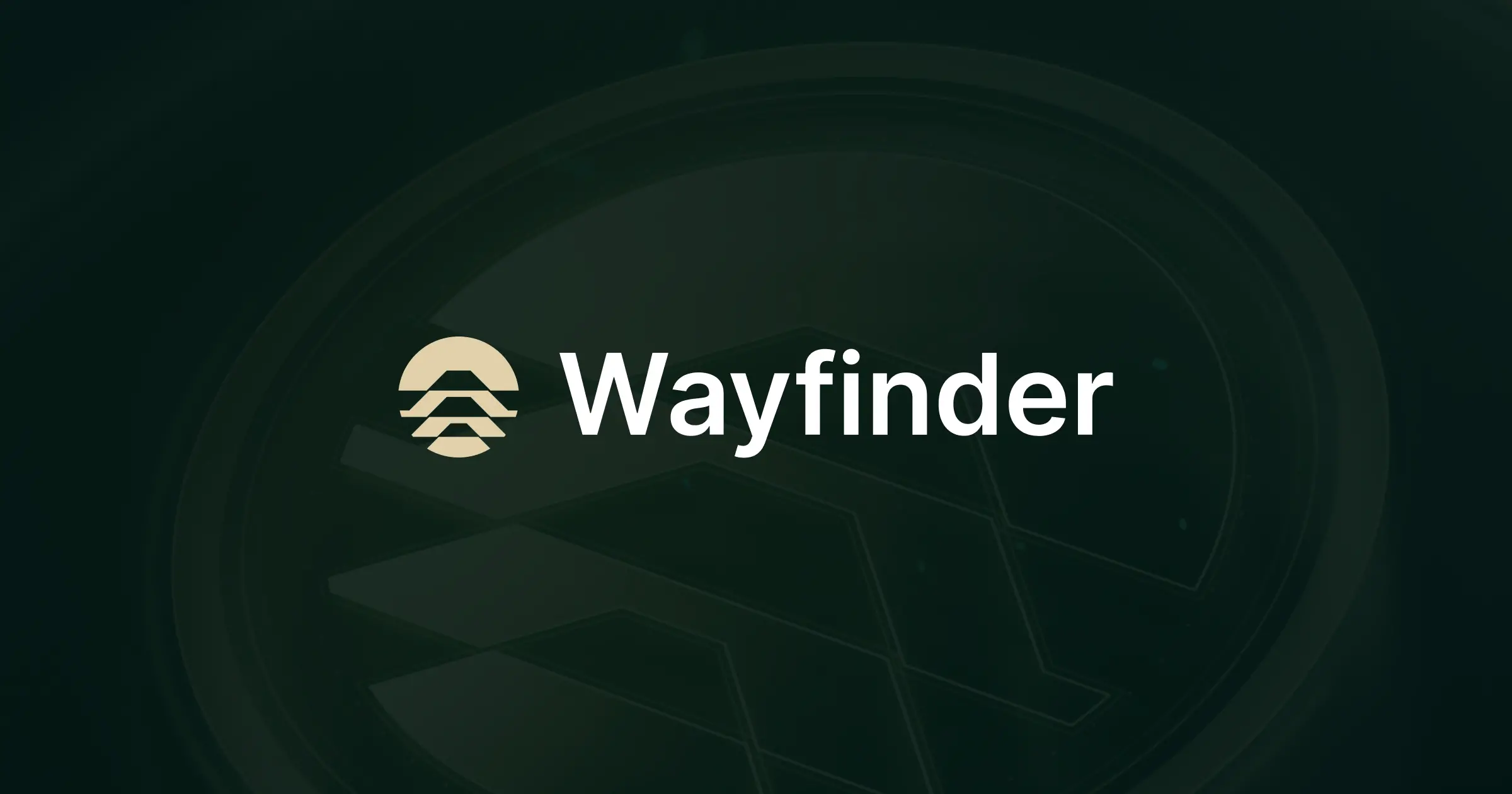The breakthrough moment of DeFi: the financial transformation of ether.fi, Aave, Sky, and Lido
Original Title: “DeFi's Breakthrough Moment: Inside the Financial Transformation of EtherFi, Aave, Maker, & Lido”
Written by: Kairos Research
Compiled by: Luffy, Foresight News
Abstract
This report aims to explore some of the most influential DeFi protocols from a financial perspective, including a brief technical overview of each protocol and an in-depth study of their revenues, expenditures, and token economics. Given the unavailability of regularly audited financial statements, we estimate Aave, Maker (Sky), Lido, and ether.fi using on-chain data, open-source reports, governance forums, and conversations with project teams. The table below presents some key conclusions drawn throughout the research, providing readers with a comprehensive understanding of the current status of each protocol. While the price-to-earnings ratio is a common method for assessing project overvaluation and undervaluation, key factors such as dilution, new product lines, and future profit potential can provide a more comprehensive picture.

Notes: 1. DAI savings rate is included in revenue costs but not in Aave's safety module; 2. Excludes ether.fi token incentives as they are in the form of airdrops; 3. This is a rough estimate based on growth rates from new products (GHO, Cash, etc.), interest rates, ETH price appreciation, and margin, and should not be considered investment advice; 4. Aave is currently seeking to improve token economics, including AAVE buybacks and distributions.
The analysis concludes that after years of liquidity guidance and moat building, we are witnessing some protocols transition to a phase of sustainable profitability. For example, Aave has reached a turning point, achieving profitability for several consecutive months and rapidly developing a new, higher-margin loan product through GHO. ether.fi is still in its early stages but has accumulated over $6 billion in total locked value, ensuring its place among the top five DeFi protocols by scale. This liquidity re-staking leader has also learned from some of Lido's shortcomings, launching several other higher-yielding auxiliary products to fully leverage its billions in deposits.
Problem Statement and Definition
Since the rise of DeFi in 2020, on-chain data and analytical tools have steadily improved, with companies like Dune, Nansen, DefiLlama, TokenTerminal, and Steakhouse Financial playing key roles in creating real-time dashboards about the status of crypto protocols. At Kairos Research, we believe that fostering credibility within the industry is crucially linked to promoting standardization across protocols and DAOs to showcase financial performance, health, and sustainability. Profitability is often overlooked in cryptocurrency, but value creation is the only way to sustainably coordinate each participant within a protocol (users, developers, governance, and community).
Here are some terms we will use throughout the research to attempt to standardize the approximate costs of each protocol.
Total Revenue / Fees: Includes all revenue generated by the protocol, belonging to both the protocol's users and the protocol itself.
Take Rate: The percentage of fees charged by the protocol to users.
Net Revenue: The protocol's revenue remaining after paying fees to protocol users and deducting revenue costs.
Operating Expenses: Various protocol expenditures, including salaries, contractors, legal and accounting, auditing, gas costs, grants, and potential token incentives.
Net Operating Income: The net dollar amount remaining after deducting all costs incurred by the protocol and token holders (including token incentives related to protocol operations).
Adjusted Earnings: Adding back one-time expenses to earnings to more accurately forecast future earnings, minus known future costs not yet expressed through earnings.
Protocol Overview
We will provide a detailed analysis of the core products offered by each highlighted protocol in this report, covering some of the most mature protocols across various crypto segments.
Aave
Aave is a "decentralized, non-custodial liquidity protocol where users can participate as suppliers, borrowers, or liquidators." Suppliers deposit crypto assets to earn loan yields and gain borrowing power, allowing them to leverage or hedge their deposited positions. Borrowers are either over-collateralized users seeking leverage and hedging or those utilizing atomic flash loans. Borrowers must pay a fixed or floating interest rate for the specific assets they borrow. Aave's protocol fees are the total interest paid on open (unrealized), closed, or liquidated positions, which are then distributed between lenders/suppliers (90%) and the Aave DAO treasury (10%). Additionally, when a position breaches its specified loan-to-value ratio limit, Aave allows "liquidators" to perform liquidation. Each asset has its own liquidation penalty, which is then distributed between the liquidator (90%) and the Aave DAO treasury (10%). Aave's new product GHO is an over-collateralized, cryptocurrency-backed stablecoin. The introduction of GHO allows Aave to provide loans without relying on third-party stablecoin suppliers, giving them greater flexibility in interest rates. Furthermore, GHO cuts out intermediaries and allows Aave to capture all borrowing interest from outstanding GHO loans.

Aave transparently displays all income, expenditures, and other data of the DAO through the Tokenlogic dashboard. We extracted "financial income" data from August 1 to September 12 and annualized these figures, resulting in a net income of $89.4 million. To derive the total revenue figure, we relied on TokenTerminal's profit and loss data to estimate profit margins. Our 2025 projections are primarily based on assumptions, including the upward trend in crypto asset prices leading to increased borrowing capacity. Additionally, in our model, Aave's net profit margin increases due to GHO potentially replacing third-party stablecoins and improvements in the protocol's safety module, which will be further explained later.
The leading lending market in cryptocurrency is expected to see its first profitable year in 2024. Multiple indicators suggest Aave's profitability potential: supplier incentives have been exhausted, active loans continue to rise, and the active borrowing amount exceeds $6 billion. Aave is clearly a significant beneficiary of the liquid staking and re-staking market, as users deposit LST/LRT, borrow ETH, convert ETH into liquid staking tokens, and then repeat the process. This cycle allows Aave users to earn net interest margins (APY related to LST/LRT deposits - Aave borrowing interest) without taking on significant price risk. As of September 12, 2024, ETH is Aave's largest outstanding borrowed asset, with all on-chain active loans exceeding $2.7 billion. We believe this trend, driven by the proof-of-stake + re-staking concept, has transformed the on-chain lending market, significantly increasing the utilization of protocols like Aave in a sustainable manner. Before the popularity of re-staking-driven cyclical lending, these lending markets were primarily dominated by leveraged users who tended to only borrow stablecoins.
The launch of GHO creates a new, higher-margin lending product for Aave. It is a synthetic stablecoin, and borrowing costs do not need to be paid to suppliers. It also allows the DAO to offer slightly lower rates than the market, thereby driving borrowing demand. From a financial perspective, GHO is undoubtedly one of the most important aspects Aave needs to focus on in the future, as this product has:
High upfront costs (technology, risk, and liquidity)
Over the next few years, costs for audits, development work, and liquidity incentives will gradually decrease
Relatively large upside potential
Outstanding GHO supply of $141 million, accounting for only 2.35% of Aave's total outstanding loans and 2.7% of DAI supply
Currently, non-GHO stablecoins (USDC, USDT, DAI) borrowed on Aave are close to $3 billion
Profit margins higher than Aave's lending market
While issuing stablecoins requires consideration of other costs, it should be cheaper than having to pay third-party stablecoin suppliers
MakerDAO's net income margin is 57%, while Aave's margin is 16.31%
The fully diluted valuation (FDV) of Aave's native token AAVE is $2.7 billion, equivalent to about 103 times its annual earnings (estimated at $26.4 million), but we believe this figure will change in the coming months. As mentioned above, favorable market conditions will increase borrowing capacity, stimulate new demand for leverage, and potentially accompany liquidation income. Finally, even if GHO's market share growth merely cannibalizes Aave's traditional lending market, it should have a direct positive impact on profit margins.
MakerDAO
MakerDAO (renamed to Sky) is a decentralized organization that supports the collateralization of various cryptocurrencies and real-world assets to issue stablecoins (DAI), allowing users to leverage their assets while providing the crypto economy with a "decentralized" stable value store. Maker's protocol fees consist of the "stability fee," which is made up of interest paid by borrowers and the income generated from assets allocated to the protocol. These protocol fees are distributed to MakerDAO and depositors who deposit DAI into the DAI Savings Rate (DSR) contract. Like Aave, MakerDAO also charges liquidation fees. When a user's position falls below the necessary collateral value, the assets will be settled through an auction process.

MakerDAO has thrived over the past few years, thanks to liquidations during the speculative volatility of 2021. However, with rising global interest rates, MakerDAO has also created more sustainable, lower-risk business lines by introducing new collateral assets, such as U.S. Treasury bonds, which enable Maker to enhance asset efficiency and generate returns exceeding standard DAI borrowing rates. In exploring DAO expenditures, we clearly understand the following points:
DAI is deeply rooted in the entire crypto ecosystem (CEX, DeFi), allowing Maker to avoid spending millions on liquidity incentives.
The DAO excels at prioritizing sustainability.
Throughout 2024, Maker is expected to generate approximately $88.4 million in net protocol income. MKR's valuation is $1.6 billion, only 18 times its net income. In 2023, the DAO voted to modify the protocol's token economics to return part of the income to MKR holders. As DAI continues to accumulate borrowing rates (stability fees) into the protocol, Maker has accumulated system surpluses, aiming to maintain it around $50 million. Maker has introduced a smart burn engine to utilize surplus funds to repurchase MKR in the market. According to Maker Burn, 11% of the MKR supply has been repurchased and used for burning, protocol-owned liquidity, or treasury building.

Lido
Lido is the largest liquid staking service provider on Ethereum. When users stake ETH through Lido, they receive "liquid staking tokens," allowing them to avoid the waiting period for unstaking and the opportunity cost of not being able to use staked ETH in DeFi. Lido's protocol fees are the ETH earnings paid for validating the network, distributed to stakers (90%), node operators (5%), and the Lido DAO treasury (5%).

Lido is an interesting case study in DeFi protocols. As of September 10, 2024, they have staked 9.67 million ETH through their protocol, accounting for about 8% of the total ETH supply and over 19% of the staking market share, with a total locked value of $22 billion. However, Lido still lacks profitability. What changes can be made to enable Lido to achieve cash flow in the short term?
In just the past two years, Lido has made significant progress in cost-cutting. Liquidity incentives have been crucial in guiding stETH, and advanced users naturally tend to prefer LST due to its superior liquidity across the ecosystem. We believe that with stETH having an impressive moat, Lido DAO will be able to further reduce liquidity incentives. Even with cost-cutting, a potential profit of $7 million may not be enough to justify LDO's FDV of over $1 billion.
In the coming years, Lido must seek to expand revenues or cut costs to reach its valuation level. We see several potential growth avenues for Lido, either through the ETH staking rate across the network continuing to rise from 28.3% or Lido striving to expand beyond the Ethereum ecosystem. We believe that, over a sufficiently long time frame, the former is likely to be achieved. In contrast, Solana's staking rate is 65.5%, Sui's is 79.5%, Avalanche's is 49.2%, and Cosmos Hub's is 61%. By doubling the amount of ETH staked while maintaining its market share, Lido could generate over $50 million in net income. This assumption is overly simplistic and does not account for the compression of ETH issuance rewards as staking rates increase. While an increase in Lido's current market share is also possible, we see serious doubts about Ethereum's social consensus regarding Lido's dominance in 2023, marking a peak in its growth momentum.
ether.fi
Similar to Lido, ether.fi is a decentralized, non-custodial staking and re-staking platform that issues liquid receipt tokens for users' deposits. ether.fi's protocol fees include ETH staking earnings and income from active validation services, which are used to provide economic security through the Eigenlayer ecosystem. ETH staking earnings are distributed to stakers (90%), node operators (5%), and the ether.fi DAO (5%), followed by Eigenlayer/re-staking rewards distributed to stakers (80%), node operators (10%), and ether.fi DAO (10%). ether.fi has many other auxiliary products that can generate substantial income, including "Liquid," which is a repository of re-staking and DeFi strategies designed to maximize depositors' yields. Liquid charges a management fee of 1-2% on all deposits, which will be accounted for in the ether.fi protocol. Additionally, ether.fi recently launched a Cash debit/credit card product, allowing users to make payments in real life using re-staked ETH.

As of September 2024, ether.fi is the undisputed market leader in the liquidity re-staking space, with a TVL of $6.5 billion for its re-staking and yield products. We attempt to simulate the potential protocol income for each of its products using the following assumptions in the financial statements above:
Assuming ether.fi's current staking volume remains unchanged for the remainder of this year, the average TVL staked in 2024 will be approximately $4 billion.
The average ETH staking yield this year will decline by about 3.75%.
The pre-listing FDV of EIGEN is approximately $5.5 billion, with re-staking rewards scheduled for 2024 at 1.66% and 2025 at 2.34%, meaning ether.fi's direct income from EIGEN will be: approximately $38.6 million in 2024 and approximately $54.4 million in 2025.
By studying EigenDA, Omni, and other AVS reward programs, we estimate that a total of approximately $35-45 million in rewards will be paid to Eigenlayer re-stakers, with an annual yield of 0.4%.
Cash is the most challenging revenue source to model, as it has just launched, and the entire field lacks transparent precedents. We will work with the ether.fi team to make the best estimates for 2025 based on booking demand and the revenue costs of large credit card providers, and we will closely monitor this over the next year.
While we recognize that ETHFI token incentives are a cost to the protocol, we have decided to leave them at the bottom of the financial statements for the following reasons: these costs were heavily invested upfront due to airdrops and liquidity guidance, and they are not necessary costs for business development. We believe that EIGEN + AVS rewards are sufficient to offset the costs of ETHFI incentives. Given that the withdrawal function has been enabled for some time, ether.fi has experienced significant net outflows, and we believe the protocol is closer to achieving its long-term sustainable TVL goals.
Token Value Accumulation and Scoring System
In addition to simply assessing the profitability of these protocols, it is also worth exploring where the earnings of each protocol ultimately flow. Regulatory uncertainty has been a driving force behind the creation of numerous revenue distribution mechanisms. Methods such as distributing dividends to token stakers, buybacks, token burns, treasury accumulation, and many other unique approaches have been adopted in an attempt to engage token holders in the protocol's development and incentivize participation in governance. In an industry where token holders' rights do not equate to shareholder rights, market participants must thoroughly understand the role their tokens play within the protocol. We are not lawyers and do not take any position on the legality of any distribution method; we merely explore the market's response to each method.
Stablecoin / ETH Dividends:
Pros: Measurable benefits, higher quality returns
Cons: Taxable events, gas consumption, etc.
Token Buybacks:
Pros: Tax-free, continuous purchasing power, growing funds
Cons: Prone to slippage and front-running, does not guarantee returns for holders, funds concentrated in native tokens
Buyback and Burn:
Pros: Same as above, increases earnings per token
Cons: Same as above + no fund growth
Treasury Accumulation:
Pros: Increases operational space for the protocol, diversifies funds, still controlled by DAO participants
Cons: No direct benefit to token holders
Token economics is clearly an art rather than a science, making it difficult to know whether distributing earnings to token holders is more beneficial than reinvesting them. For simplicity, in a hypothetical world where the protocol has maximized growth, having tokens that redistribute earnings would enhance holders' internal rates of return and eliminate risk each time they receive some form of payout. We will explore the designs and potential value accumulation of ETHFI and AAVE below, both of which are currently undergoing improvements in token economics.
Looking Ahead
Aave
Currently, the GHO supply is 142 million, with a weighted average borrowing rate of 4.62% and a weighted average stkGHO incentive expenditure of 4.52%, with 77.38% of the total GHO supply staked in the safety module. Therefore, Aave earns 10 basis points on $110 million worth of GHO and 4.62% on the unstaked $32 million. Considering global interest rate trends and stkAAVE discounts, the GHO borrowing rate certainly has room to drop below 4.62%, so we have also increased our forecasts for GHO impacts to 4% and 3.5%, respectively. In the coming years, Aave should have many opportunities to promote GHO growth, and the following chart predicts how the path to $1 billion in outstanding GHO loans will impact protocol earnings.

While Aave has growth potential, Marc Zeller has also proposed a temperature check within Aave's governance forum to improve the protocol's expenditures and the native token AAVE. The premise of the improvement is that Aave is rapidly becoming a profitable protocol, but it is currently paying excessively for an imperfect safety module. As of July 25, Aave's safety module had $424 million, primarily composed of stkAAVE and stkGHO, both of which are imperfect assets that cannot cover bad debts caused by slippage and decoupling risks. Additionally, through token issuance, the protocol is incentivizing the secondary liquidity of AAVE, minimizing slippage if stkAAVE must be used to cover bad debts.
If the DAO votes to use aTokens like awETH and aUSDC as the safety module while isolating stkGHO to only repay GHO debts, this concept could undergo a complete transformation. stkGHO would never need to be sold to cover bad debts; it could simply be confiscated and burned. The aforementioned aTokens are highly liquid and constitute a significant portion of the protocol's debt. If under-collateralized, these staked aTokens could be confiscated and burned to cover bad debts. The goal of this proposal is to reduce expenditures on the safety module and liquidity incentives. Zeller further explains the role of stkAAVE under the new plan in the following diagram.

If this proposal is passed, it should have a favorable impact on the AAVE token, as it will have more stable demand while also allowing holders to earn rewards without the risk of stkAAVE being confiscated to cover bad debts. We are uncertain about the tax implications of the staking contract, but it greatly benefits long-term holders of AAVE through continuous purchasing power and the redistribution of tokens to stakers.
ether.fi
Given ether.fi's success in rapidly creating sustainable business models, establishing multiple profit initiatives is quite appealing. For example, the protocol's development team and DAO act very quickly, proposing that the company repurchase 25%-50% of the income generated from Restaking & Liquid products for ETHFI, to be used for liquidity provision and capital reserves. However, considering the lack of AVS rewards, the substantial startup costs incurred upfront, and the fact that most of its product suite is brand new, using 2024 earnings data to calculate fair valuation may be futile and complex.
The FDV of the ETHFI token is $1.34 billion, with a slight profit expected this year (excluding liquidity incentives), making it very similar to Lido's LDO. Of course, ether.fi must withstand the test of time, and the protocol has faster profitability potential than Lido, with a higher earnings ceiling given the ongoing success of its broader product offerings. Below is a conservative analysis of how AVS rewards will contribute to protocol earnings. AVS reward earnings are the rewards that re-stakers receive solely from AVS expenditures.

As seen with Lido, liquid staking/re-staking is a highly competitive industry with relatively thin profits. ether.fi has fully recognized this limitation and is exploring the creation of broader yield auxiliary products while capturing market share. Here are the reasons we believe these other products align with its broader re-staking and yield generation theory.
Liquid: We firmly believe that LRT advanced users are familiar with DeFi Lego blocks and wish to maximize yields, thus attracting them to use products that can automate their DeFi strategies. Once AVS rewards truly "go live," dozens of risk/return strategies and a new form of native yield will emerge in the crypto economy.
Cash: Similar to LST, LRT is a superior form of collateral compared to regular ETH, with sufficient liquidity. Users can use liquid re-staking as a yield-generating checking account or borrow assets for daily expenses at almost zero cost.










